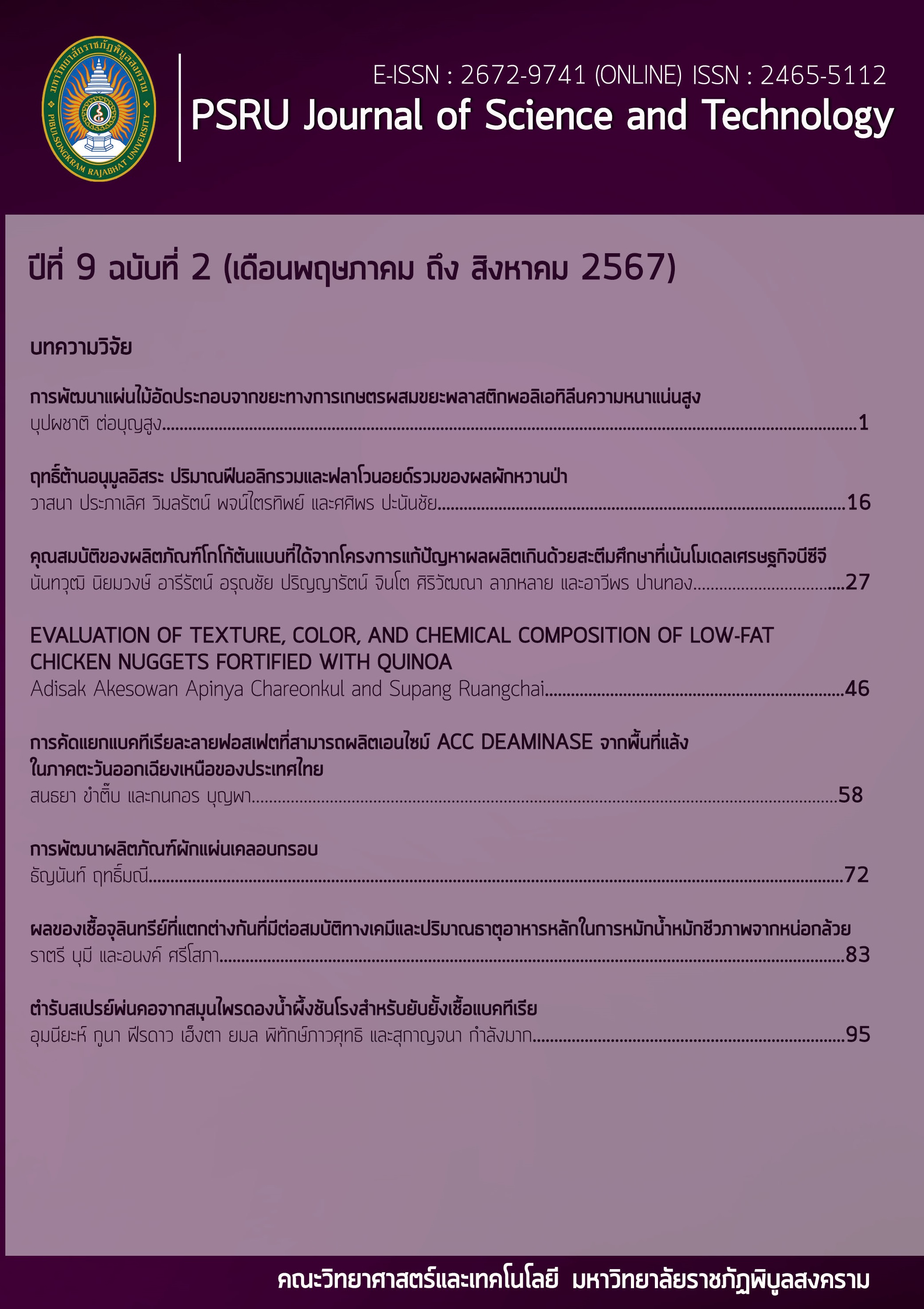CHARACTERISTICS OF PROTOTYPE COCOA PRODUCTS FROM THE OVERPRODUCTION PROBLEM-SOLVING PROJECT THROUGH STEAM EDUCATION WITH A FOCUS ON THE BCG ECONOMIC MODEL
Keywords:
The properties of cocoa products, quality inspection, youth volunteers, Overproduction Problem-Solving Project, BCG Economic ModelAbstract
This research aims to study the physical, chemical, and biological characteristics of prototype products derived from technology transfer through the "Overproduction Problem-Solving Project through STEAM Education with a Focus on the BCG Economic Model" project. The project focuses on transferring technology for processing fresh cocoa into various cocoa-based foods for communities of farmers in the learning group in the Ban Rai district, Uthai Thani province. After completing the project, two prototype products, namely craft cocoa and chocolate bars, underwent microbiological analysis to determine the total bacteria, yeast and mold and the presence of Bacillus cereus in the samples. Additionally, physical properties such as particle size and surface characteristics of the products were examined under a Scanning Electron Microscope (SEM). Chemical properties, including pH, moisture content, acid value, and free fatty acid, were also analyzed. Craft cocoa and chocolate bars exhibited good quality due to controlled processing temperatures (well-tempered), with moisture content values of 2.82% and 2.34%, and pH values of 5.95 and 5.76, respectively. The percentage of free fatty acid (palmitic acid) in craft cocoa and chocolate bars was found to be 1.54% and 1.31%. Microbiological examination of the products, particularly chocolate, met the safety standards set by the Ministry of Public Health. The results demonstrate the potential of these value-added and safe food products for production in agricultural communities in the area.
References
กรมวิชาการเกษตร. (2566). สถานการณ์การผลิตโกโก้. สืบค้นเมื่อวันที่ 5 มกราคม 2566, จาก https://www.doa.go.th/
hort/wp-content/uploads/2020/12/สถานการณ์การผลิตโกโก้_พฤศจิกายน 63.pdf
กรมวิทยาศาสตร์การแพทย์. (2556). วิธีมาตรฐานสำหรับการวิเคราะห์อาหาร เล่มที่ 1. นนทบุรี: กรมวิทยาศาสตร์การแพทย์ กระทรวงสาธารณสุข.
กรมวิทยาศาสตร์การแพทย์. (2557). วิธีมาตรฐานสำหรับการวิเคราะห์อาหาร เล่มที่2. นนทบุรี: กรมวิทยาศาสตร์การแพทย์ กระทรวงสาธารณสุข.
กรมวิทยาศาสตร์การแพทย์. (2558). วิธีมาตรฐานสำหรับการวิเคราะห์อาหาร เล่มที่ 3. นนทบุรี: กรมวิทยาศาสตร์การแพทย์ กระทรวงสาธารณสุข.
การเกษตรต่างประเทศ. (2566). ข่าวสารเกษตรต่างประเทศ. สืบค้นเมื่อวันที่ 10 เมษายน 2566, จาก https://www.moac.go.th/foreignagri-news-preview-451091791211
ประกาศกระทรวงสาธารณสุข. (2566). ราชกิจจานุเบกษา, 140 (ตอนพิเศษ 153), 29 – 33.
ประกาศกระทรวงสาธารณสุข. (2563). ราชกิจจานุเบกษา, 137 (ตอนพิเศษ 237 ง), 9.
Afoakwa, E.O., Paterson, A., & Fowler, M. (2007). Factors influencing rheological and textural qualities in chocolate: a review. Trends Food Sci Technol, 18(6), 290–298.
AOAC. (2000). Official Methods of Analysis. (17th ed.). Gaithersburg: Association of Official Analytical Chemists International.
American Oil Chemists’ Society. (2017) Official Methods and Recommended Practices of the American Oil Chemists Society. (7th ed.). USA: AOCS Press, Champaign, IL.
American Oil Chemists’ Society. (2009). Official Methods and Recommended Practices of the American Oil Chemists Society. (6th ed.). USA: AOCS Press, Champaign, IL.
Beckett, C., Mansell, R. (2008). Crossing Boundaries: New Media and Networked Journalism. Communication culture & critique, 1(1), 92-104.
Gutiérrez, T.J. (2017). State-of-the-Art Chocolate Manufacture: A Review. Comprehensive Reviews in Food Science and Food Safety, 16(6), 1313-1344.
James, B., & Smith, B. (2009). Surface structure and composition of fresh and bloomed chocolate analysed using X-ray photoelectron spectroscopy, cryo-scanning electron microscopy and environmental scanning electron microscopy. LWT-Food Science and Technology, 42(5), 929-937.
Krapf, T., & Gantenbein-Demarchi, C. (2010). Thermal inactivation of Salmonella spp. During conching. LWT-Food Science and Technology, 43(4), 720–723.
McGaw, LJ., Jäger, AK., & Van Staden, J. (2002). Isolation of antibacterial fatty acids from Schotia brachypetala. Fitoterapia, 73(5), 431-433.
Mulono, A. (2017). Analysis of Amino Acids in Cocao Beans Produced during Fermentation by High Performence Liquid Chromatography (HPLC). International Journal of Food and Fermentation Technology, 7(1), 25.
Quispe-Sanchez, L., Caetano, A.C., Baca, D., Oliva-Cruz, M., Díaz-Valderrama, J.R., & Chavez, S.G. (2023). Fatty acid profile and rheological properties of cocao paste from north-eastern Peru. Journal of Food Composition and Analysis, 123, 1-8.
Russell, D. (2015). Manual of Methods of Analysis of Foods. New Delhi: Food Safety and Standards Authority of India.
Seidel, V., & Taylor, PW. (2004). In vitro activity of extracts and constituents of Pelagonium against rapidly growing mycobacteria. International Journal of Antimicrobial Agents, 23(6), 613-619.
Vásquez, Z.S., Carvalho Neto, D.P.d., Pereira, G.V.M., Vandenberghe, L.P.S., Oliveira, Priscilla, Z.d., Tiburcio, P.B., Rogez, H.L.G., Góes Neto, A., & Soccol, C.R. (2019). Biotechnological Approaches for Cocao Waste Management: A Review. Waste Management, 90, 72–83.
Downloads
Published
How to Cite
Issue
Section
License
Copyright (c) 2024 PSRU Journal of Science and Technology

This work is licensed under a Creative Commons Attribution-NonCommercial-NoDerivatives 4.0 International License.
กองบรรณาธิการขอสงวนสิทธิ์ในการปรับปรุงแก้ไขตัวอักษรและคำสะกดต่างๆ ที่ไม่ถูกต้อง และต้นฉบับที่ได้รับการตีพิมพ์ในวารสาร PSRU Journal of Science and Technology ถือเป็นกรรมสิทธิ์ของคณะวิทยาศาสตร์และเทคโนโลยี มหาวิทยาลัยราชภัฏพิบูลสงคราม และ
ผลการพิจารณาคัดเลือกบทความตีพิมพ์ในวารสารให้ถือมติของกองบรรณาธิการเป็นที่สิ้นสุด







